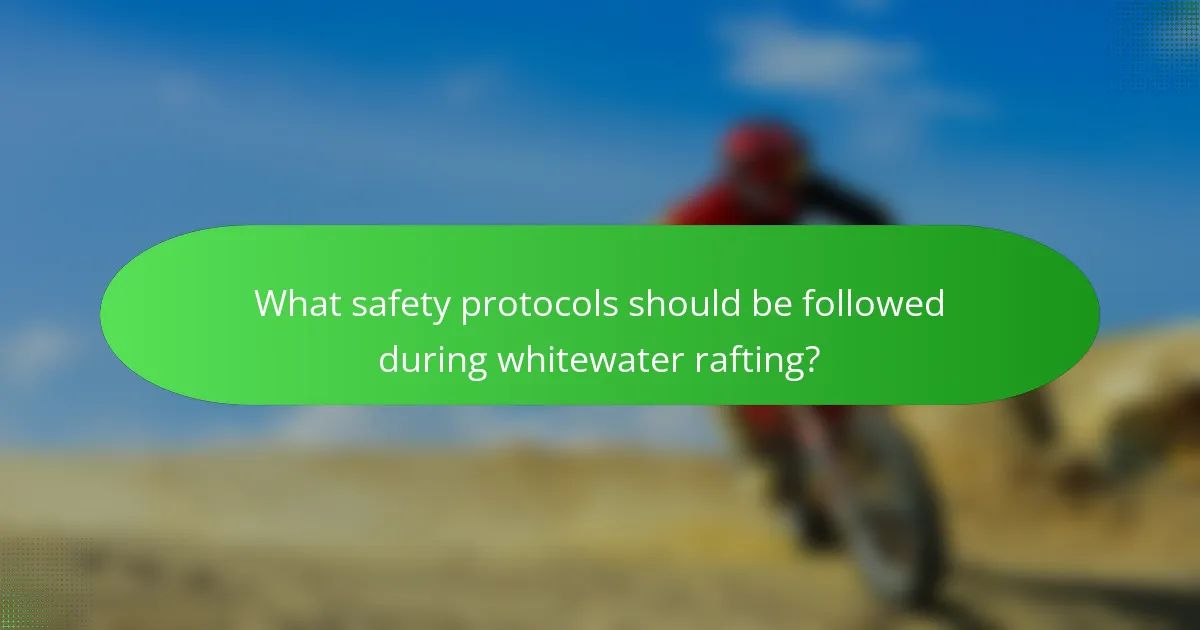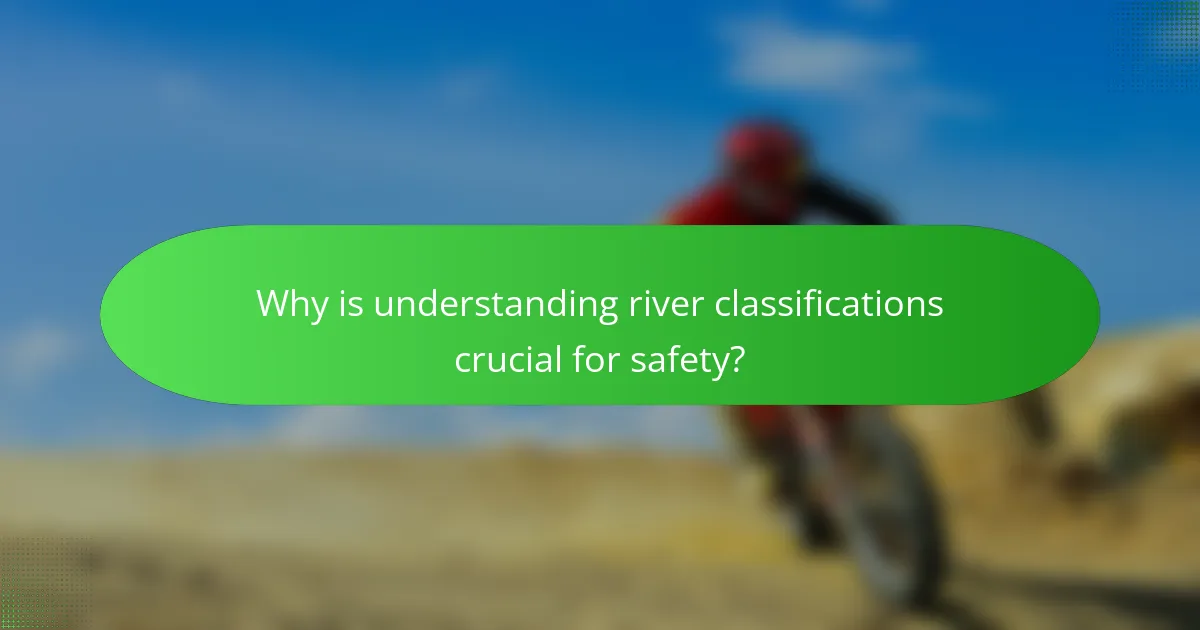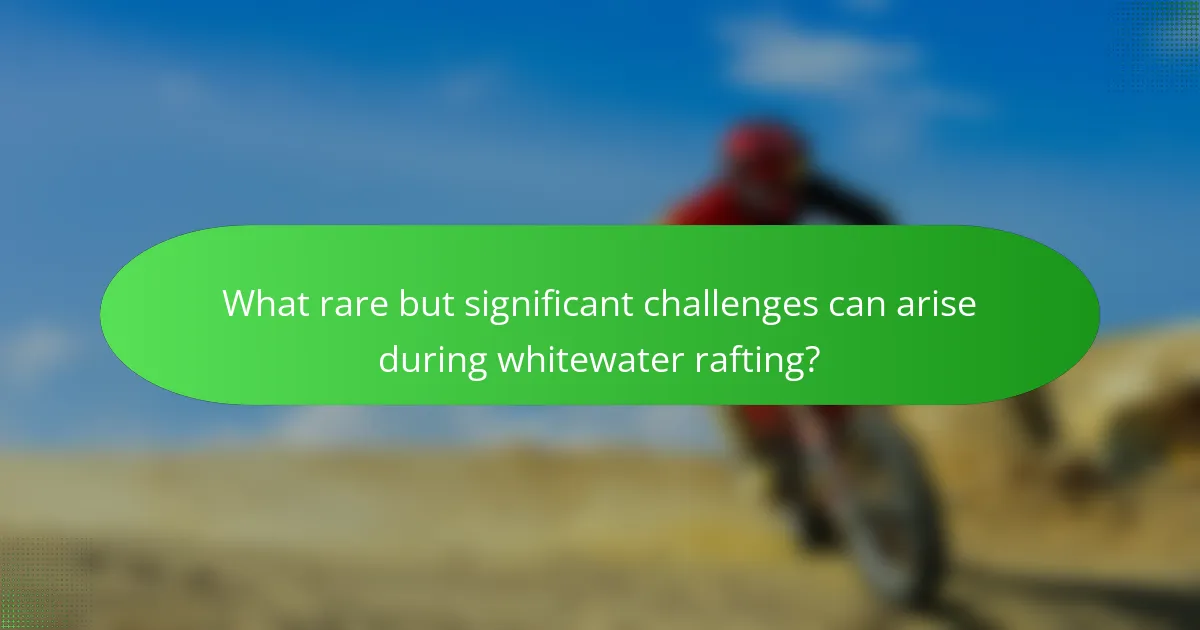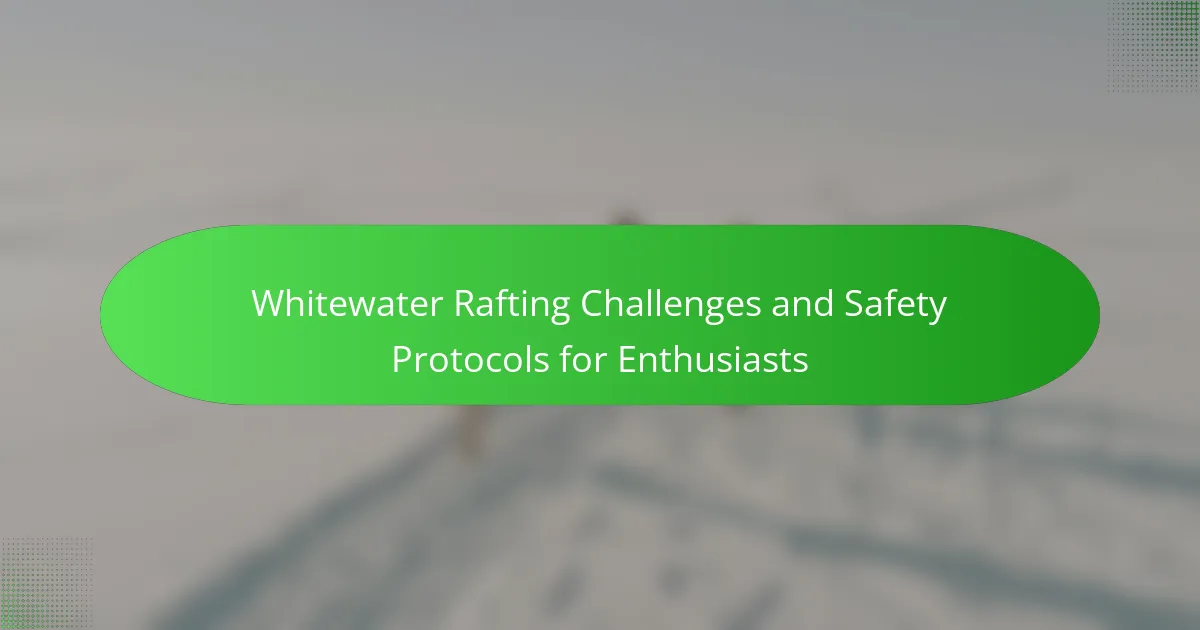Whitewater rafting offers thrilling adventures but comes with significant challenges and safety risks. Enthusiasts must navigate unpredictable water conditions, understand river classifications, and adhere to essential safety protocols. Proper gear, teamwork, and communication are crucial for a safe experience. Additionally, awareness of rare challenges like sudden weather changes and equipment failure can enhance safety and enjoyment on the river.

What are the primary challenges faced by whitewater rafting enthusiasts?
Whitewater rafting enthusiasts face challenges such as unpredictable water conditions, safety risks, and physical demands. Navigating rapids requires skill and experience, as currents can change rapidly. Safety protocols are essential, including wearing life jackets and helmets. Additionally, teamwork is crucial for managing the raft effectively.
How do water conditions impact rafting safety?
Water conditions significantly impact rafting safety by influencing river flow, obstacle visibility, and overall hazard levels. High water levels can increase rapid currents, making navigation more challenging. Low water levels may expose rocks and other hazards, creating risks of capsizing or collisions.
Factors such as temperature and weather also play a role. Cold water can lead to hypothermia, while heavy rainfall can cause sudden changes in water levels. Rafting protocols should include monitoring weather forecasts and river conditions prior to embarking.
Enthusiasts should assess their skill level against current conditions. For example, beginners should avoid high-water situations, while experienced rafters may seek out challenging rapids. Understanding these variables is crucial for ensuring a safe and enjoyable experience on the water.
What equipment is essential for tackling difficult rapids?
Essential equipment for tackling difficult rapids includes a high-quality inflatable raft, personal flotation devices, paddles, helmets, and safety ropes. These items ensure safety and enhance performance in challenging conditions. A sturdy raft provides stability, while life jackets are crucial for buoyancy. Helmets protect against head injuries, and paddles allow for maneuverability. Safety ropes assist in rescue scenarios. Investing in reliable gear is vital for a safe and enjoyable whitewater rafting experience.
How do varying skill levels affect challenge perception?
Varying skill levels significantly influence challenge perception in whitewater rafting. Beginners may view rapids as intimidating, while experienced rafters often see them as exciting opportunities for adventure.
Skill levels affect risk assessment, with novices more likely to underestimate their capabilities and overestimate dangers. As a result, safety protocols become essential for less experienced participants.
Conversely, seasoned rafters understand their limits and can navigate challenges with greater confidence. This nuanced perception enhances their enjoyment and engagement in the activity.
Moreover, group dynamics play a role; mixed skill levels can lead to varying perceptions of safety and challenge, impacting overall team performance and cohesion.

What safety protocols should be followed during whitewater rafting?
Safety protocols during whitewater rafting include wearing appropriate gear, following guides’ instructions, and maintaining communication. Always wear a personal flotation device, helmet, and suitable clothing. Ensure the raft is equipped with safety equipment like ropes and first aid kits. Understand the river’s conditions and potential hazards. Prioritize teamwork and practice self-rescue techniques.
What are the key safety gear requirements for rafters?
Key safety gear requirements for rafters include personal flotation devices, helmets, and appropriate clothing. Personal flotation devices must be U.S. Coast Guard-approved and fit snugly. Helmets protect against head injuries from obstacles. Clothing should be quick-drying and suitable for varying water temperatures. Additionally, a first aid kit and a whistle enhance safety during rafting excursions.
How do guides ensure safety on the river?
Guides ensure safety on the river by implementing strict protocols and utilizing their expertise. They assess water conditions and select appropriate routes, ensuring that all participants are equipped with safety gear. Guides conduct safety briefings to educate rafters on procedures and emergency protocols. They monitor group dynamics and maintain communication throughout the journey, adapting plans as needed to respond to changing conditions.
What emergency procedures should every rafter know?
Every rafter should know essential emergency procedures to ensure safety. Key procedures include self-rescue techniques, signaling for help, and swift water navigation skills.
1. Self-Rescue: Learn to swim effectively in swift water and how to use flotation devices.
2. Communication: Use whistles or hand signals to alert others in case of danger.
3. Group Coordination: Establish a plan for regrouping after a capsize.
4. First Aid: Familiarize yourself with basic first aid for injuries that may occur on the river.
5. Equipment Checks: Regularly inspect gear for safety and functionality before each trip.
Understanding these procedures can significantly enhance safety during whitewater rafting adventures.

Which unique attributes differentiate various whitewater rafting experiences?
Unique attributes that differentiate various whitewater rafting experiences include river class, guiding expertise, and safety equipment. River class determines the difficulty level, ranging from Class I (easy) to Class VI (extremely difficult). Guiding expertise varies, influencing safety and enjoyment. Safety equipment, such as helmets and life jackets, may differ by location and company, impacting overall safety protocols.
How do regional river characteristics influence rafting difficulty?
Regional river characteristics significantly influence rafting difficulty by affecting water flow, obstacles, and currents. Factors such as gradient, width, and water volume determine the challenge level. For instance, steep gradients create rapid water flow, increasing difficulty. Additionally, narrow rivers may have more obstacles, while wider rivers can allow for smoother navigation. Understanding these attributes helps enthusiasts select appropriate routes and ensure safety protocols are in place.
What unique challenges do group sizes present in rafting?
Group sizes in rafting present unique challenges such as coordination difficulties, safety management, and group dynamics. Larger groups can complicate communication among participants, increasing the risk of accidents. Additionally, ensuring everyone’s safety becomes more complex, particularly in turbulent waters. Smaller groups may struggle with resource allocation, making it harder to secure necessary equipment and support. Balancing fun and safety becomes crucial, as larger groups may create a chaotic environment. Ultimately, understanding these challenges helps in planning safer and more enjoyable rafting experiences.

Why is understanding river classifications crucial for safety?
Understanding river classifications is crucial for safety to assess the challenges and risks of whitewater rafting. Different classifications indicate water conditions, including rapid intensity and potential hazards. For instance, Class I rivers are suitable for beginners, while Class V rivers present extreme challenges requiring expert skills. Recognizing these classifications helps enthusiasts prepare adequately, choose appropriate gear, and ensure proper training. This knowledge ultimately reduces accidents and enhances the overall safety of the rafting experience.
What do the different river classifications indicate about safety risks?
Different river classifications indicate varying safety risks for whitewater rafting. Class I rivers are easy and safe, while Class VI rivers present extreme hazards. Understanding these classifications helps enthusiasts prepare adequately for the challenges ahead.
Class I: Flat water, minimal risk
Class II: Small waves, some skill needed
Class III: Moderate rapids, risk of capsizing
Class IV: Difficult rapids, advanced skills required
Class V: Extremely challenging, expert level
Class VI: Unraftable, life-threatening conditions
These classifications guide safety protocols, ensuring participants select appropriate rivers based on their skill level and experience.
How can classification knowledge enhance the rafting experience?
Classification knowledge enhances the rafting experience by improving safety awareness and skill development. Understanding the different classes of rapids helps enthusiasts select appropriate routes and prepare for challenges. Knowledge of safety protocols, such as wearing life jackets and understanding rescue techniques, significantly reduces risks. This preparation fosters confidence, allowing participants to enjoy the adventure while minimizing potential hazards.

What rare but significant challenges can arise during whitewater rafting?
Rare but significant challenges during whitewater rafting include sudden weather changes, equipment failure, and hidden obstacles. These challenges can lead to dangerous situations, requiring quick decision-making and adherence to safety protocols. For instance, unexpected storms can increase river flow and create hazardous conditions. Equipment failure, such as a punctured raft, can compromise safety and necessitate immediate evacuation. Hidden obstacles like submerged rocks can pose risks to navigation, emphasizing the need for thorough scouting and awareness. Proper training and preparation are essential to mitigate these rare challenges effectively.
How do weather changes affect rafting conditions unexpectedly?
Weather changes can significantly impact rafting conditions, often unexpectedly. Sudden rain can increase water levels, leading to swift currents and potential hazards. Conversely, temperature drops can cause water to become dangerously cold, affecting safety protocols. Wind can create challenging waves, while storms may introduce debris into the water. Understanding these factors is crucial for enthusiasts to ensure safety and adapt plans accordingly.
What are the infrequent but critical risks associated with wildlife encounters?
Infrequent but critical risks associated with wildlife encounters during whitewater rafting include sudden animal attacks, unexpected wildlife presence, and zoonotic disease exposure. These risks can lead to serious injuries or health issues.
Wildlife encounters can occur unpredictably, especially in remote areas. For instance, interactions with bears or snakes may happen unexpectedly, posing significant safety threats. Understanding these risks enhances preparedness and safety protocols for rafting enthusiasts.
Moreover, specific safety measures should be in place, such as avoiding areas known for high wildlife activity and maintaining a safe distance from animals. Awareness of local wildlife behavior can also mitigate risks.
Lastly, injuries from wildlife encounters can be severe, highlighting the importance of emergency response plans. Being equipped with first aid knowledge and emergency contacts is essential for all rafters.

What best practices can enhance safety and enjoyment in whitewater rafting?
To enhance safety and enjoyment in whitewater rafting, follow these best practices. Always wear a properly fitted personal flotation device. Understand the river’s class rating to gauge difficulty. Communicate effectively with your team and establish clear roles. Practice self-rescue techniques and familiarize yourself with the equipment. Stay aware of changing weather conditions and river levels.
How can rafters effectively communicate during a trip?
Rafters can effectively communicate during a trip by using clear signals and maintaining constant eye contact. Establishing a set of hand signals before starting enhances coordination. Additionally, verbal cues should be concise and loud enough to be heard over the water noise. Regular check-ins among team members foster connection and ensure everyone is aware of the group’s status.
What are common mistakes that new rafters should avoid?
New rafters should avoid common mistakes to ensure safety and enjoyment. Key errors include neglecting safety gear, underestimating river conditions, and ignoring group communication.
1. Skipping personal flotation devices can lead to serious accidents.
2. Misjudging water levels and currents may result in dangerous situations.
3. Failing to discuss roles and signals with team members can create confusion during maneuvers.
4. Overpacking can affect the raft’s stability and maneuverability.
5. Ignoring weather forecasts can expose rafters to unexpected hazards.
What expert tips can seasoned rafters share for a safer experience?
Experienced rafters emphasize preparation and awareness for a safer whitewater experience. Key tips include understanding river conditions, wearing appropriate gear, and practicing effective communication with your team.
1. Assess river conditions before departure, including water levels and weather forecasts.
2. Always wear a properly fitted personal flotation device (PFD) and helmet.
3. Use a reliable paddle, and ensure all equipment is in good condition.
4. Communicate clearly with your team about safety protocols and signals.
5. Practice rescue techniques regularly, so everyone knows their role in emergencies.
6. Stay alert and focused, avoiding distractions during navigation.
These practices enhance safety and enjoyment while tackling the challenges of whitewater rafting.
